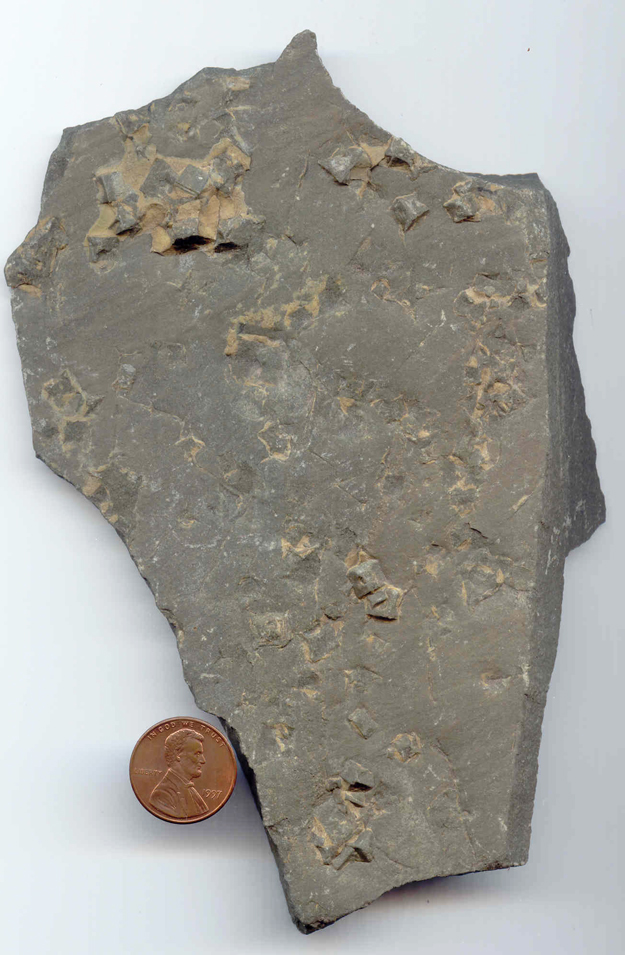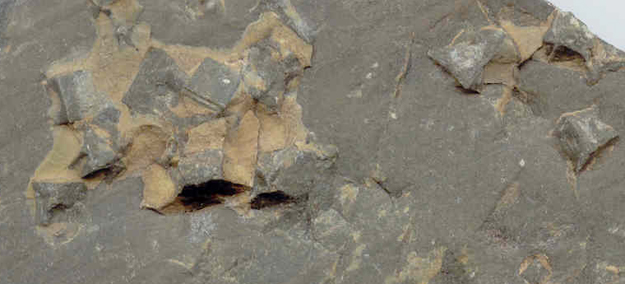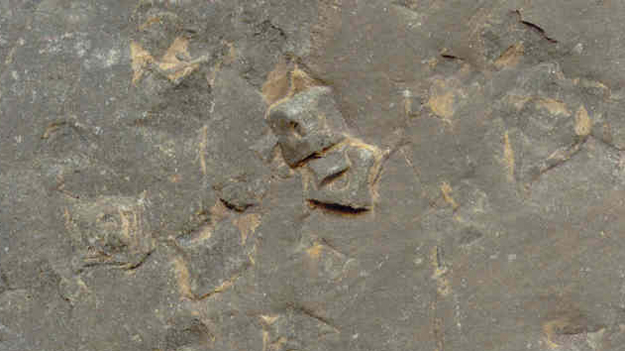17 August 2011
Halite Casts from Belt argillite
Posted by Callan Bentley
I collect a lot of samples when I roam the west on my summer georoadtrips. Yesterday when I got back to my office at NOVA, I unloaded about 200 pounds of rocks from my Prius. These samples are all destined to serve as teaching aides for NOVA and GMU students in lab exercises and/or hallway displays.
One of the samples I scored this summer that I am very excited to put to use in teaching is this sample of olive-colored argillite (metamudstone) from the Belt Supergroup:

(Scanned image; penny for scale) Two close-ups:


I’m interpreting those cube-shaped protrusions are halite (salt) casts, indicating that the water that was depositing this green mud got hypersaline occasionally, and that caused NaCl become oversaturated. Crystals nucleated on the seafloor and grew in the cubic habit of halite, only to be buried by new mud and dissolved away, with mud filling in that cube-shaped void space to create muddy casts of the original crystals.
Along with other primary sedimentary structures like mudcracks, stromatolites, and ripple marks, these salt casts suggest a relatively shallow environment of deposition for the Belt Supergroup during the Mesoproterozoic era of geologic time. This sample is destined to join the “sedimentary structures” lab sample set for my Historical Geology course.


 Callan Bentley is Associate Professor of Geology at Piedmont Virginia Community College in Charlottesville, Virginia. He is a Fellow of the Geological Society of America. For his work on this blog, the National Association of Geoscience Teachers recognized him with the James Shea Award. He has also won the Outstanding Faculty Award from the State Council on Higher Education in Virginia, and the Biggs Award for Excellence in Geoscience Teaching from the Geoscience Education Division of the Geological Society of America. In previous years, Callan served as a contributing editor at EARTH magazine, President of the Geological Society of Washington and President the Geo2YC division of NAGT.
Callan Bentley is Associate Professor of Geology at Piedmont Virginia Community College in Charlottesville, Virginia. He is a Fellow of the Geological Society of America. For his work on this blog, the National Association of Geoscience Teachers recognized him with the James Shea Award. He has also won the Outstanding Faculty Award from the State Council on Higher Education in Virginia, and the Biggs Award for Excellence in Geoscience Teaching from the Geoscience Education Division of the Geological Society of America. In previous years, Callan served as a contributing editor at EARTH magazine, President of the Geological Society of Washington and President the Geo2YC division of NAGT.
[…] a follow up to last week’s post about halite casts in a hand sample I collected in western Montana’s Belt Supergroup, here’s another […]
[…] previously mentioned the lovely salt casts that can be found in Mesoproterozoic argillites of the Belt (“Purcell” in Canada) […]